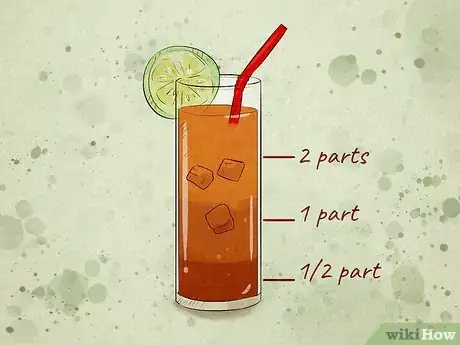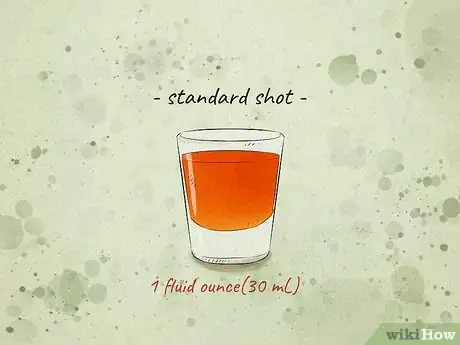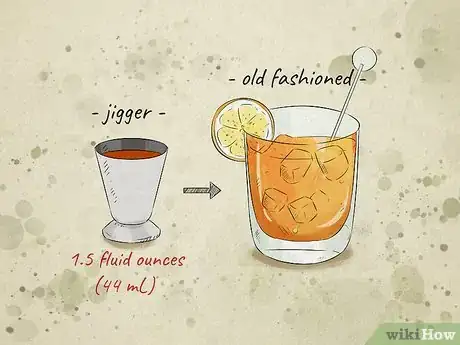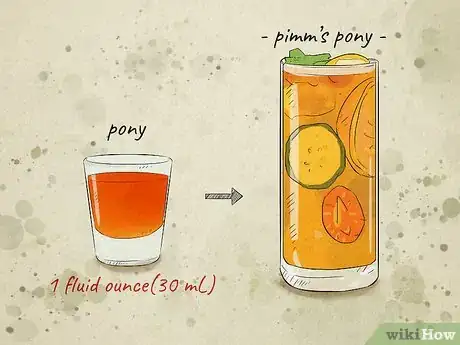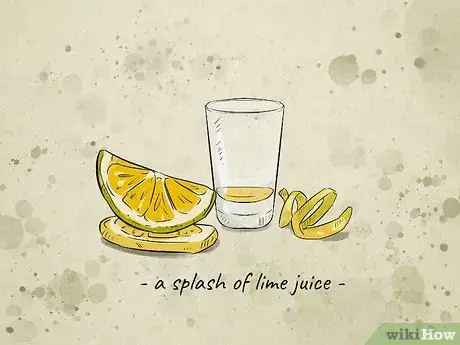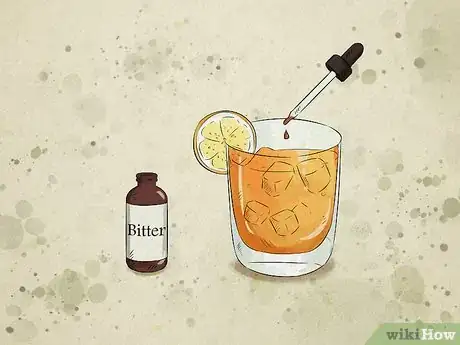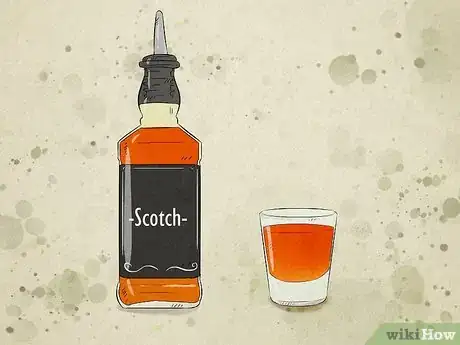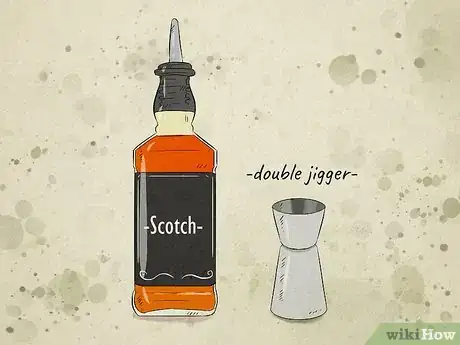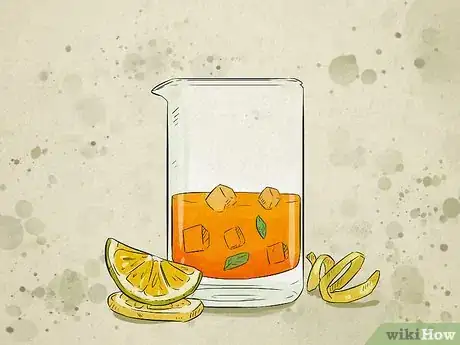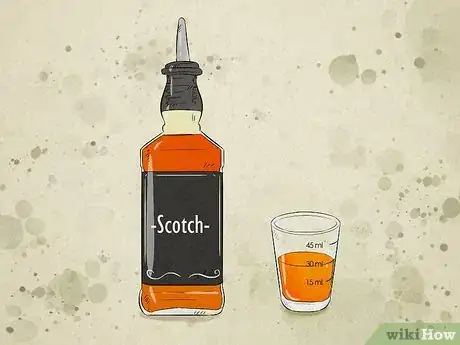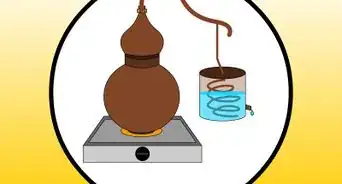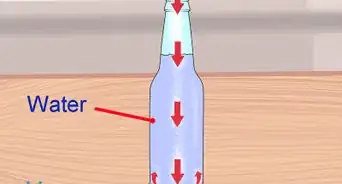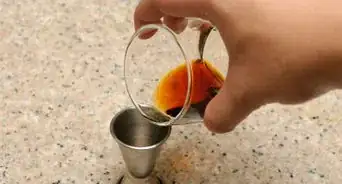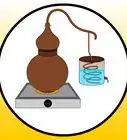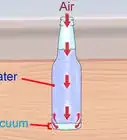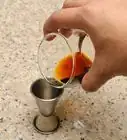This article was co-authored by Mimi Perryman and by wikiHow staff writer, Hannah Madden. Mimi Perryman is a Bartender and the Owner of Events with LML, an events company based in the Los Angeles Metropolitan Area but serving the full state of California. With over 15 years of experience in the serving industry, she specializes in traveling bartender services and event planning. She earned a BS in Marketing from California State University-Dominguez Hills, is ServSafe & RBS Certified, and carries a bartending license. She also has a Marketing & Graphic Design background and is a member of the American Marketing Association. Events with LML has a 5-star rating on Yelp and is a featured vendor on The Knot.
This article has been viewed 444,853 times.
Cocktails are a fun way to mix alcohol and other ingredients to create delicious tasting drinks. Some cocktail recipes call for strange-sounding measurements that can be hard to convert into ounces or milliliters. If you want to impress your friends and family by making great cocktails, understand how much alcohol is in a shot, use measuring tools, and use your judgement to determine when a drink tastes good.
Steps
Learning Measurement Names
-
1Measure parts based on the volume of your serving glass. When a drink calls for “parts,” it is referring to the ratio of ingredients within the cocktail. You can take some liberties with how much of a certain drink you would like to make. This is great for drinks where you may want to make a pitcher for a large gathering.[1]
- For example, if a recipe calls for 1 part vodka and 2 parts tonic water, you can either pour 1 shot of vodka and 2 shots of tonic water, or 2 shots of vodka and 4 shots of tonic water, etc.
-
2Pour 1 fluid ounce (30 mL) of alcohol for a standard shot. Shot glasses can come in different shapes and sizes. If a recipe is calling for a shot of alcohol, pour 1 fluid ounce (30 mL) into your drink. A double shot refers to 2 shots, which is 2 fluid ounces (59 mL).[2]
- Many recipes don’t require their alcohol measurements to be exact.
Advertisement -
3Use 1.5 fluid ounces (44 mL) of alcohol if your cocktail calls for a jigger. A jigger is a measuring tool that holds a little over 1 shot of alcohol. If you don’t have a jigger, you can measure out 1.5 fluid ounces (44 mL) of alcohol to mix into your drink. Some jiggers hold different amounts of liquid, but a standard one is 1.5 fluid ounces (44 mL).[3]
- Only classic cocktails, like Old Fashioneds and Cosmopolitans, will use this measurement.
-
4Pour 1 fluid ounce (30 mL) of alcohol if your drink calls for a pony. A pony gets its name from the classic American shot glass. This amount of alcohol is slightly less than the standard shot glass used now. Use slightly less than a full shot of alcohol if your recipe calls for this measurement.[4]
- Cocktails that call for a pony will usually say it in their name, like Pimm’s Pony Cocktail or the Pony Express Cocktail.
-
5Count to 1 while you pour for a splash of something. A splash is a measurement that is fairly subjective. You can standardize it slightly by counting to 1 while you pour your splash of whatever ingredient the recipe calls for. You can add more or less if you choose to do so.[5]
- If you are uncertain, pour a small amount of your ingredient and taste it. Add more if you think it needs it.
- Cocktails often call for splashes of citrus juices, simple syrups, and berry juices.
-
6Use 3 to 6 drops of bitters for a dash. When a recipe calls for a dash, it is most often referring to bitters in a cocktail. A dash is another measurement that is very subjective. Add 3 to 6 drops of bitters to your drink depending on how you like your drink. Start with less and add more if you would like to.[6]
Tip: Dashes are such a small measurement that a slight discrepancy between drinks won’t make that much of a difference.
Using Measurement Tools
-
1Attach a bottle spout on liquor bottles for control during a free pour. Free pours are when you pour alcohol straight from the bottle without using a measuring tool. To give you better control, attach a meal bottle spout on the mouth of a liquor bottle before you pour. These spouts help slow down the flow of liquor.[7]
- Some pour spouts have a metal ball inside of them. As you tip the bottle and use the pour spout, the metal ball slowly drops and blocks the stopper after a specific amount of alcohol gets poured out.
Tip: Count in your head as you free pour alcohol. 1 count is 0.25 fluid ounces (7.4 mL), 2 counts is 0.5 fluid ounces (15 mL), 3 counts is 0.75 fluid ounces (22 mL), and 4 counts is 1 fluid ounce (30 mL).
-
2Use a double jigger for shots and double shots of alcohol. Double jiggers have openings on both ends instead of just 1. The smaller opening holds about a shot of alcohol, and the larger opening holds about 2 shots of alcohol. Pour your alcohol into 1 side of the jigger up until the fill line. Then, pour your liquid into a cocktail glass.[8]
- Some jiggers are slightly bigger or smaller than a shot or double shot.
-
3Pour ingredients into a cocktail beaker to measure as you pour. Cocktail beakers hold between 3 fluid ounces (89 mL) and 5 fluid ounces (150 mL). Cocktail beakers are helpful tools to make most drinks. If you only have a few ingredients, pour them 1 at a time into a cocktail beaker. Add up the amounts of all the ingredients that you have, and subtract them from the total as you pour them into the beaker.[9]
- For example, if your recipe calls for 2 fluid ounces (59 mL) of vodka, 1 fluid ounce (30 mL) of triple sec, and 1 fluid ounce (30 mL) of lime juice, add those up to get 4 fluid ounces (120 mL). Use the measurements on the side of the beaker to measure each ingredient until you get to 4 fluid ounces (120 mL).
-
4Measure your ingredients in a measuring cup for an easy conversion. If you don’t have any bartending specific tools, use a clear measuring cup that you already have. Ones that don’t hold much volume are the best because they will have smaller measurements on the side. Pour your ingredients in the measuring cup 1 at a time and add them up as you go.[10]
- For example, if your recipe calls for 1 fluid ounce (30 mL) of Campari, 2 fluid ounces (59 mL) of orange juice, and 1 fluid ounce (30 mL) of sparkling water, use your measuring cup to pour each ingredient one at a time until you reach 4 fluid ounces (120 mL).
Community Q&A
-
QuestionHow much is a "splash"?
 Community AnswerA splash is a dash, but if you need an exact measurement, it would be a 1/4 teaspoon to a 1/2 teaspoon. Try the 1/4 teaspoon first, and see what you think. You can always increase on the next drink.
Community AnswerA splash is a dash, but if you need an exact measurement, it would be a 1/4 teaspoon to a 1/2 teaspoon. Try the 1/4 teaspoon first, and see what you think. You can always increase on the next drink. -
QuestionWhat does 2 cups mean; how do I know what size cups to use?
 Community AnswerA cup is a unit of fluid measurement equal to 8 ounces US.
Community AnswerA cup is a unit of fluid measurement equal to 8 ounces US. -
QuestionWhat does the measurement "ct" mean?
 Community AnswerCt means "count" so if it specifies "a 4 ct" that means you will pour it upside down for a four second count. Note that this assumes you have a liquor pourer fitted onto your bottle.
Community AnswerCt means "count" so if it specifies "a 4 ct" that means you will pour it upside down for a four second count. Note that this assumes you have a liquor pourer fitted onto your bottle.
Expert Interview

Thanks for reading our article! If you'd like to learn more about measuring cocktail ingredients, check out our in-depth interview with Mimi Perryman.
References
- ↑ https://www.themanual.com/food-and-drink/guide-cocktail-measuring-tools-tricks-terms/
- ↑ https://www.diffordsguide.com/encyclopedia/322/cocktails/measuring-cocktail-ingredients
- ↑ http://www.onlineunitconversion.com/shot_to_jigger.html
- ↑ https://www.themanual.com/food-and-drink/guide-cocktail-measuring-tools-tricks-terms/
- ↑ https://www.themanual.com/food-and-drink/guide-cocktail-measuring-tools-tricks-terms/
- ↑ https://www.thekitchn.com/when-it-comes-to-cocktails-whats-in-a-dash-behind-the-bar-218109
- ↑ https://www.themanual.com/food-and-drink/guide-cocktail-measuring-tools-tricks-terms/
- ↑ https://www.theatlantic.com/health/archive/2010/07/measure-like-a-mixologist-a-guide-to-jiggers/60688/
- ↑ https://www.themanual.com/food-and-drink/guide-cocktail-measuring-tools-tricks-terms/
About This Article
To understand cocktail measurements, know that a splash of something should be a little bit more than a dash, but still not very much. Also, if a drink calls for a jigger of something, you should use 1 1/2 fluid ounces, which is equal to 1 shot. If a recipe calls for a pony of something, use 1 fluid ounce. You should also be careful using shot glasses to measure out drinks since they come in a variety of sizes, from 1 fluid ounce to 3 fluid ounces. To learn how to convert drink measurements into parts, scroll down!
